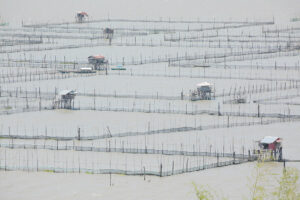By Andre Christopher H. Alampay
AGRICULTURAL OUTPUT is estimated to have slowed or fallen in the third quarter after a sharp drop in fisheries volume, with analysts and industry officials also skeptical of the performance of the hog industry due to the continuing African Swine Fever (ASF) outbreak.
If borne out, their worries about the third quarter would check the momentum gained a quarter earlier, when output rose 5.7% year on year, the strongest performance in eight years.
Nevertheless, the crops subsector is expected to turn in a positive performance, despite the impact of typhoons and flooding during the period.
Former Agriculture Secretary William D. Dar said via Viber that crop output likely rose 1% despite the typhoons and two major earthquakes in Cebu and the Davao region.
“The growth would have been higher if not for these challenges and problems… farmers continue with dedication to plant rice,” he said.
He credits the Masagana Rice Industry Program and the Rice Competitiveness Enhancement Fund in supporting farmers and farm production during this quarter.
Federation of Free Farmers National Manager Raul Q. Montemayor said via Messenger that output of palay (unmilled rice) will likely rise during the period, coming off a low year-earlier base of 3.33 million metric tons (MMT).
He added that the third-quarter 2023 volume of 3.8 MMT remains out of reach “due to reduced plantings because of low palay prices.”
The Philippine Statistics Authority’s own updated estimate based on the standing crop is 3.93 MMT, which would be up 18% year on year but down 9.7% from a quarter earlier.
Corn production is expected to come in at around 2.4 MMT for the quarter, down 0.4% year on year but up 62.1% from the second quarter.
Mr. Dar also said livestock and poultry were “not growing well” or could post “minimal growth,” though he added that the poultry segment is “rebounding.”
Former Agriculture Undersecretary Fermin D. Adriano said via Viber that livestock production remains a worry due to ASF.
Mr. Adriano said official assessments of the ASF situation could be too optimistic.
The Bureau of Animal Industry (BAI) reported a drop-off in the geographic scope of ASF outbreaks this year. As of Oct. 3, the BAI said the number of barangays with active ASF cases dropped to 31 from 505.
These reports, Mr. Adriano said, do not take into account the sharp decline in the swine population.
“At a certain level of decrease, decline will plateau. This does not mean we have checked for the spread of disease… It will undoubtedly be checked if there is an increase in swine population without a setback for a period of time.”
Mr. Adriano said that if an effective vaccine against ASF is not rolled out, farmers will have to resort to drastic isolation measures as did Spain and China.
Such a strategy “will have adverse consequences to backyard raisers who cannot afford the cost of biosecurity measures,” he said.
National Fisheries Research and Development Institute Board Member Norberto Chingcuanco said via Messenger that fisheries production will fall after storms affected major aquaculture sites like Taal Lake and Pangasinan.
Fisheries production had fallen 5.1% in the third quarter of 2024, also due to typhoons. The government announced this week that fisheries production by volume in the third quarter fell 7.5% to 894.32 thousand metric tons.
Mr. Chingcuanco said the Bureau of Fisheries and Aquatic Resources and the Department of Environment and Natural Resources need to find regions to farm fish that are not along the usual typhoon track.
He named Lake Mainit in northeast Mindanao, the Pantabangan Dam reservoir in Nueva Ecija, and Naujan Lake in Oriental Mindoro as potential sites to invest in.
Agriculture output data will be released today, Nov. 6.

